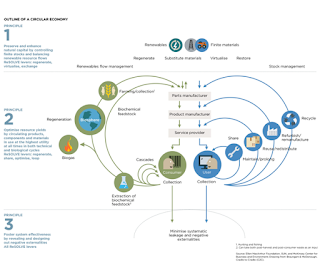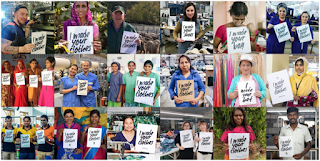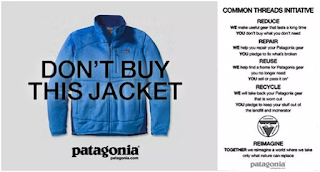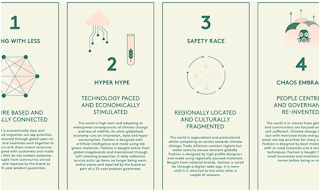Clothes are an everyday
necessity and for many a central part of self-expression and creativity.
Fashion, however, is a dirty business. The current fast-paced production of
clothes is incredibly resource intensive, wasteful, exploitative and
pollution-heavy.
According to the United Nations “the fashion industry,
including the production of all clothes which people wear, contributes to
around 10% of global greenhouse gas emissions due to its long supply chains and
energy intensive production. The industry consumes more energy than the
aviation and shipping industry combined.”
Besides the emissions
associated with today’s fashion industry, every item of clothing comes with a
cost - both environmental and social.
According to the
documentary film River Blue, one fashion brand will use over
28 trillion gallons of water every year. In addition to the actual use of
precious drinking water, clothing manufacturers are dumping toxic chemicals
into nearby rivers which are killing off animal life, contaminating water and
sky-rocketing occurrences of death and disease in affected people.
People are also
affected in the way of workers exploitation. Garment workers are forced with
unsafe working conditions and being paid far below a living wage.
But there is hope. The Fashion Transparency Index reports that
there’s been a “280% rise in tier-one supplier transparency from fashion brands
since 2016.”
We are seeing greater
pressure and demand to transform the fashion industry to be ethical and
sustainable whilst incredibly innovative and exciting transformations are already
afoot.
Here are just five
examples of trailblazers in the sustainable fashion space.
The
Ellen MacArthur Foundation - Promoting a shift to circular economy
In 2010, Dame Ellen
McArtur launched the foundation to promote a paradigm shift towards a circular
economy, particularly in the fashion industry. The circular economy looks at
moving away from the current linear model of our economy which is to
take-make-dispose. Circular economy transcends our current extractive
industrial model by “gradually decoupling economic activity from the
consumption of finite resources, and designing waste out of the system.”
Circular economy is
underpinned by a transition to renewable energy sources and building rather
than depleting natural and social capital. It is based on three principles:
● Design
out waste and pollution
● Keep
products and materials in use
● Regenerate
natural systems
Fashion
Revolution - Ending exploitation and ecological damage caused by fashion
Fashion Revolution is a
group of “designers, academics, writers, business leaders, policymakers,
brands, retailers, marketers, producers, makers, workers and fashion lovers”
who aim to “unite people and organisations to work together towards radically
changing the way our clothes are sourced, produced and consumed, so that our
clothing is made in a safe, clean and fair way.”
Fashion revolution
hosts a number of online and offline events all over the world, including the
annual Fashion Revolution Week which put pressure on brands to reveal
#whomademyclothes.
The organisation has
released a manifesto with ten principles to which the
fashion industry should uphold itself and are engaging with top fashion brands
through their transparency index.
Patagonia
- Subscribing to activism as a modern clothing brand
As far as large
clothing brands leading the way on sustainable fashion practices go, Patagoina
comes out top. Patagonia proudly markets themselves as an “activist company”
and attempts to transparently prove why they deserve that name. Patagonia
actively practices responsible resource management whilst promoting longer-use
and better care of their products in order to reduce consumerist impact.
The company
transparently communicates their journey to improve their supply chain and
reduce their carbon footprint whilst even taking part in direct action and
activism. Their central focus is on the lives of their workers. Considering the
current environmental crisis we face currently, we need more companies to take
an active stand like Patagonia has.
Kye
Shimizu - Using technology and tradition to decrease fashion waste
According to
Sustainable living platform Twyg Mag, “Kye Shimizu is not a fashion
designer, but his Algorithmic Couture project has created a new convention for
fashion,” using code to eliminate waste and make fashion sustainable.”
Kye is the co-founder
of Synflux,
a Tokyo-based research collective that focuses on design research and fashion
design. Together with is co-founders Yusuke Fujihira, Kotaro Sano, and Kazuya
Kawasaki, they developed a system which has taken the concept of traditional
Japanese straight-line pattern cutting and combined it with technology,
The Algorithmic Couture
project:
● captures
body measurements and data of a customer,
● then
creates a 2D zero waste digital patterns using straight lines;
● outfits
are designed using these straight line patterns in collaboration with a
designer;
● the
customer is able to customize color and fabric type;
● outfit
is made to fit the consumer whilst avoiding fabric waste.
Forum
for the Future - Open source information for the future of fashion
In partnership with the
Centre for Sustainable Fashion at the London College of Fashion and with support
from C&A Foundation, Forum for the Future has launched Fashion Futures 2030, “an open-source learning toolkit to help
fashion businesses plan for future scenarios with sustainability in mind.”
-
climate change
-
resource shortages
-
population growth
-
And other factors that will shape the
world of 2030 and the future of the fashion industry.
The next 10 years are going to be some
of the most important in the entire human history. All individuals, governments
and industry will have to make widespread unprecedented changes if we are to
avoid climate catastrophe and further devastating biodiversity loss. Embracing
sustainable and ethical fashion practices is one of the most important ways of
doing this.
Do
you want to make a difference to the fashion industry?
Sumas offers a range of sustainable
fashion courses and degrees:





No comments:
Post a Comment